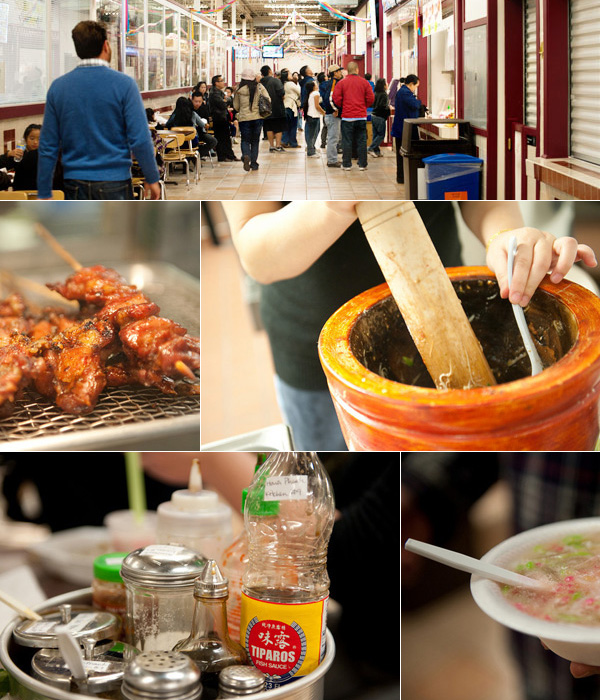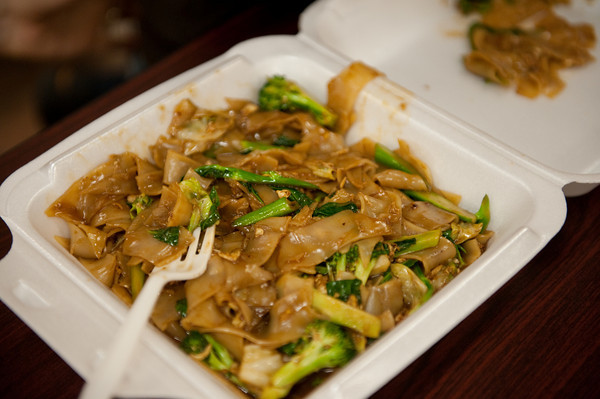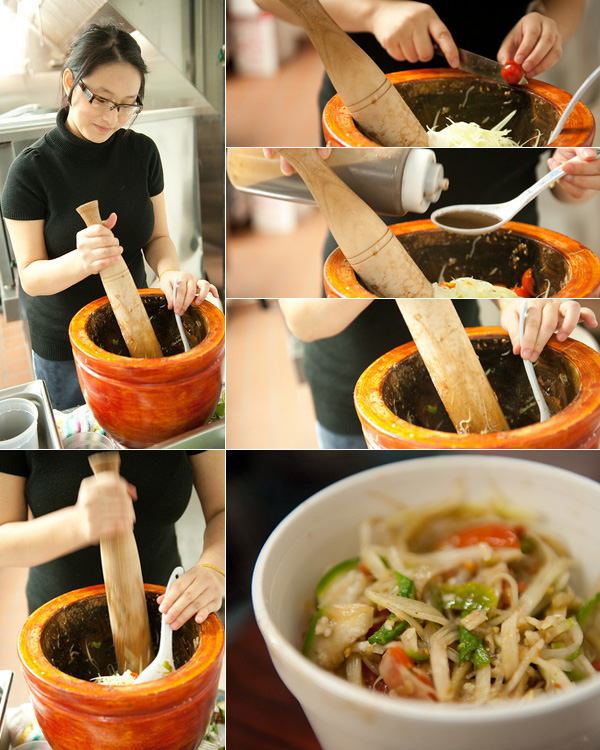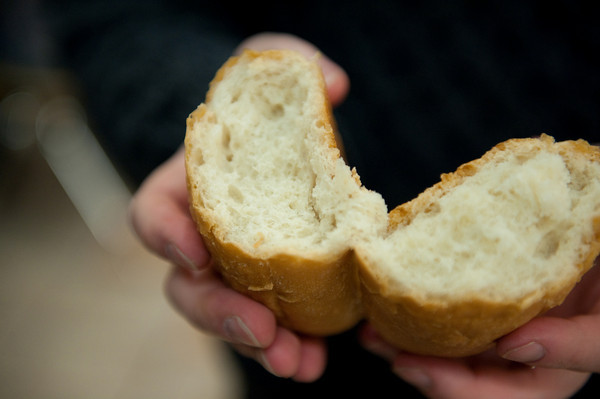
The newly opened Hmong Village shopping complex in St. Paul makes no apologies: as you walk among the literally hundreds of U-Store-It-style stalls that fill its warehouse-sized space, you quickly become aware that many, if not most, of the buyers and sellers are first-generation Hmong immigrants. Your English will be of only limited use. Even getting into the building is a challenge; it has cryptic entrances labeled with letters, all of which drop you seemingly at random into a steel and concrete labyrinth. (Once you’re in, wander at random until you hit the wall that’s nothing but restaurants — you’ll know it when you get there.)
“Do you have a Hmong guide with you?” asked the avuncular counterman at Kad’s Deli. “Most people, when they come here, have a Hmong guide to do the talking, and explain,” he added, hoping, I think, that perhaps I did have a Hmong guide somewhere whom I’d simply forgotten to introduce.

Becca Dilley / Heavy Table
When you come to Hmong Village and dine at one or more of its 17 similar food court stall-style restaurants, get ready to:
a) Pay cash
b) Visit some restaurants that only identify their dishes by number
c) Not necessarily know either exactly what you ordered, or whether you got it
Also get ready to:
a) Eat some terrific food for cheap
b) Be charmed by friendly, homespun service
c) Learn to enjoy new stuff
If you’ve eaten adventurously up and down Nicollet Ave. in Minneapolis or University Ave. in St. Paul, much of what’s served at Hmong Village will be familiar to you. But there are a number of surprises hiding among the eateries, and the sheer number of restaurants in such a confined space makes the Hmong Village food court a real (if figurative) trip.
The man at Kad’s Deli explained that the restaurant hours are generally 11am to 7pm. That said, when we arrived at 6pm, a couple restaurants were already shut down (no pig uteri for us, alas), and some of the restaurants stayed open until almost 8. “11am to about 2pm is the best time to come,” he said.
Another vendor exhorted us to come on the weekend, when the place was stuffed wall-to-wall with people and we would feel like we were truly in another country. To our mind, even on a Wednesday night: Mission accomplished.
– James Norton
Maja Ingeman, James Norton, Elizabeth Mead Cavert Scheibel, Nick Scheibel, and Jason Walker contributed to this feature.

Blueberry: Mango Passionfruit Boba Tea ($3)
By the end of the evening, we’d filled three tables with the assorted bits and pieces of about 25 different items from around 15 different restaurants. The mango passionfruit boba tea from Blueberry was the one item we ordered twice, owing to its bright fruit kick, great balance between tart and sweet, and overall unassailable deliciousness. – JN

Fue’s Cafe: Pad See Ew ($6)
Actually having a printed menu, unlike most Hmong Village stalls, makes Fue’s Cafe stand out for the first-timer. Its food does, too, based on its vegetarian Pad See Ew, made as you order with Chinese broccoli, eggs, and delectably wide, hearty noodles. The dish’s special Thai soy sauce was the key, as it elevated a simple noodle-and-veggie concoction into a well-balanced sweet-and-salty delight that was inhaled by our testers, including a 2-year-old, and was worth the trip itself. It didn’t hurt that Fue’s Cafe had samples of the dish out for all to try; after the sample it was a done deal. – JW

Papaya Salad ($5)
This papaya salad had three heat versions. The woman who made ours with a giant mortar and pestle, grinding the peppers before preparing the dish, said ours had “medium” heat. This is disputable, and for Minnesota standards, a flat-out untruth. The “hot” version must be an absolute fireball, yet with all the heat this papaya salad did not lose its flavor. Hot, yes, but the burst of flavors from loads of sweet shaved papaya, garlic, and Thai eggplant still emerged. Papaya salads are relatively common at Hmong Village; Fue’s likely sets the standard. – JW

Fried Black Sesame Cookie ($1.75 for several)
Light, exceedingly crispy, and delicate in flavor, the Fue’s Cafe sesame cookies are as pleasant to look at they are to eat. Reminiscent of an Italian pizzella, and almost exactly like a Norwegian rosette cookie. — JN

Dragon Express: Sesame Chicken with Fried Rice ($5)
Dragon Express didn’t have much to offer — just two entrees and rice, as well as fried bananas and egg rolls. Let’s hope we caught them on an off night, because the sesame chicken was fine, but certainly no better than your average China buffet. Not overly battered and well-seasoned, it didn’t scream MSG and was probably pretty darn good when it was fresh. But with the array of offerings elsewhere at Hmong Village, you’d be hard-pressed to justify this order, unless you were simply dying for an old standby. The fried rice was decent but forgettable. – JW

Famous Deli: Chicken Feet ($4)
An impulse purchase of chicken feet from Famous Deli offered a pungent hit of five-spice and scallion. Though the strong flavors provided a nice balance to the sticky texture, the visceral presentation of bone and chewy skin enrobed in the cold, seasoned gelatin leaching from the feet may prove too adventurous for the average Western palate. – MI

Spicy Chicken ($5)
A more approachable use of the flavors in the Famous Deli chicken feet can be found in the restaurant’s Spicy Chicken. A steaming plate of chicken wings loaded with scallions and hot chili oil, the dish sparkles with contrast — from the crispy deposits of sweet-spicy glaze to the moist, juicy meat underneath. We were sold on the first bite — despite many dishes to taste in one sitting, no wing was left uneaten. – MI

Her Kitchen: Pho Fawm ($6)
You get a lot for your six bucks at Her Kitchen. Yes, the bowl of pho is huge, like bowls of pho all over the city. But it’s really, really huge. And it contains more sources of protein than your tiny brain can accurately assess. From one order, we pulled pieces of beef, fish cakes, shrimp, meatballs, and tripe. (I was fairly sure I didn’t like tripe before trying this dish; now I’m positive. The rubber-band texture was its undoing.)
But tripe aside, the other elements of this dish are, as a whole, delightful. Garnished properly (with judicious scoops of chili paste, MSG, lime juice, and peanuts), the flavor explodes. And the dish’s thin, delicate noodles serve as a wonderful base for all the hot jazz going on up top. – JN

Hmong Bakery & Deli: Roll ($1)
This one is attributable to writer error. I tried to order a taro roll; they were out; somehow they gave me a non-taro roll. It tasted like a roll. If you found yourself at Hmong Village wrestling with, say, a skewer of meatballs or a skewer of lacquered chicken (both reasonable scenarios), rest assured — you can dash over to Hmong Bakery and make that skewer into a sandwich. – JN

Houa Phanh: Pho ($5)
In a pho showdown, the deciding factor is almost exclusively the broth. What Houa Phanh’s beef, shrimp, and meatball version lacks in complexity, it makes up with good, honest flavor. Prior to seasoning, each bite of broth fills your mouth with a mild, pleasantly beefy flavor which dissipates almost completely the instant you swallow — perfect to soothe a sore throat or hangover. Interestingly enough, these rice noodles seem to hold their own the next day — despite having been soaked in broth overnight, they didn’t become the glutinous, saturated mass that day-old pho noodles often devolve into. – MI

Tricolor ($1)
Among all of the stands serving tricolor, there is an excellent chance that no two serve the same version. If you have enough of a sweet tooth to withstand all the coconut and sugar that goes into that cup, one of the no-holds-barred, noodle-pearl-tapioca combinations may be your best bet. Houa Phanh’s smaller cup layered with red, green, and white pearls doused in the coconut-sugar water combination was a more restrained rendition — despite the sweetness of the liquid, the rice pearls offered a neutral, almost salty flavor which mitigated the sugar rush. — MI

Kad’s Deli: Mango Sticky Rice ($3)
This is right up there with Blueberry’s Mango Passionfruit Boba Tea in terms of being the correct way to end a meal. Generously dolloped with mild coconut cream and numerous pieces of fresh mango, the Kad’s Deli mango sticky rice is a simple, literal execution of a classic and essentially foolproof dessert. Worth seeking out and savoring every mildly sweet, bright, and creamy bite. – JN

California Rolls ($6)
Kad’s Deli sells sushi (questionable!) but restricts itself to non-raw fish varieties such as avocado rolls, cucumber rolls, and California rolls (wise!). The California Rolls are not going to put Origami out of business, but for the amount you get, they’re really not too bad — they’ve got a creamy cucumbery snap to them and very mild imitation crab meat — the overall balance is good. Hmong Village is not really the place to be hunting down sushi, but if you for some reason feel the need, you will be neither thrilled nor horrified by the offerings at Kad’s Deli. — JN

The Kitchenette: Hmong Sausage ($2)
“It’s kind of like a brat, but different.” So said our server at The Kitchenette of the long sausage which evoked images of Kobayashi going to town in a hot dog eating contest. Despite the slightly wrinkled, reddish exterior that prepared me to expect a sweetish Chinese-style sausage, this tasted instead like a Swedish potato sausage: mild, meaty, and bursting with juice that, upon biting through the sausage’s skin, could easily dribble down your chin. Pair it with some white or fried rice, and you’ve got a hearty meal of comfort food. – MI

Chicken Kebab ($2)
The moist, tender chicken kebab at The Kitchenette offers a kick of soy first and foremost, rounded out with a bit of garlic. Kept in a hot pan in a display case, each thin piece of gristle-free chicken is carefully threaded on a skewer, glazed, and grilled, keeping the moisture and garlic-soy flavor intact. – MI

K-Pho: Grilled Meatballs ($4)
These two skewers of four meatballs weren’t bad, but they didn’t stand out in any way; a fairly sweet meatball dipped in a fish sauce, rice vinegar, and sugar sauce was reminiscent of an average egg roll without the roll, and the rather pale color doesn’t do them any favors. The meatballs are also offered in a vermicelli noodle salad, and that would probably be a more satisfying choice. Or, get them into a bun for a sandwich — a couple of good-sized rolls, like those at Hmong Bakery & Deli (see above), with these meatballs, and you’ll have a quick, decent, and cheap lunch for two. These meatballs just aren’t what meatballs can be, so they’re better not left to themselves. – EMCS

Mai’s Kitchen: Papaya Salad ($5)
Procuring this papaya salad didn’t start out so well. I looked at the menu, noted some $8 dishes (the most I had seen anywhere else was $6), and just blurted out an order. The woman who took the order started making it, with a large mortar and pestle, and then asked me what I wanted. I stupidly replied, “I don’t know,” to which she replied, “you don’t know?!” I mumbled something about “trying stuff.” She handed the pestle off to another woman, who kindly endured constant questions about what she was putting in. Despite my initial reservations about the prices, $5 gets you a thick, big cup of salad, with lots of ingredients, including cherry tomatoes, another larger variety of tomato, lime, long green beans, Thai eggplant, fish sauce, shrimp paste, and a tamarind sauce. I had plenty of time to ask questions, because each batch is made to order, so be prepared to wait.
I asked for mine medium spicy (“What do you mean by medium spicy?” another employee laughed), and at first bite I wished I’d gone bigger. A minute later, the heat was building in my mouth, and within five minutes I was desperate for some boba tea — so I ended up just right. Compared to the papaya salad at Fue’s Kitchen, this salad was oversauced — less sauce would have let the flavors of the various ingredients come through more and would have resulted in a crisper texture. Still, with the varied ingredients, I found it more satisfying than Fue’s offering, and you can’t disregard the time and elbow grease that goes into this fresh product. – EMCS

Moon’s Kitchen: Tricolor ($2)
For a mere two bucks, you can have probably the most colorful and unusual dessert you’ve ever ingested: three kinds of colored noodles, tapioca pearls, a sweet creamy base, and a few extremely ass-kicking drops of almond and banana extracts. Suck it through a giant straw and brace yourself for the flavor and texture onslaught. (We somewhat preferred the Moon’s Kitchen tricolor to the Y-T Express version that came in a bowl, but the sweet-salty complexity of the Houa Phanh version was probably the consensus favorite.) -- JN

Mrs. Papaya: Congee ($3)
Mrs. Papaya was the first of the restaurants that we visited, and also perhaps the most enigmatic: There were pictures of three different meals posted, labeled #1, #2, and #3. They were out of #3, so we went with #1, which turned out to be a comforting bowl of congee (rice porridge) with fried onions, chicken, cilantro, and a hard-boiled quail’s egg. We were advised to add chili paste, which added a crucial flavor kick to an otherwise quietly soothing dish. -- JN

Nang Kwak: Pho Roll ($5)
The woman making Nang Kwak’s signature pho rolls was pulling the noodles out of a giant bowl that must’ve contained four or five gallons of the soft, pillowy things. An order of pho rolls consists of a long, ghostly white noodle rolled up into tube containing mild ground pork and scallions, cut into six pieces. The underseasoned meat makes sense in context, however; the pho rolls come with a dipping sauce that is hot and funky, containing fish sauce, peanuts, and hot chili peppers. The overall effect is wonderful: tender texture, bright hot flavors, and soothing noodles. – JN

Thai Ginger Deli: Beef Lab with Sticky Rice ($5 for the lab, $2 for the rice)
If you haven’t had lab (or larb or laab), the first thing to know is that it’s made to be eaten with your hands, by grabbing some lettuce or rice and then scooping the rest in. You can get by with a fork, but the fork will never construct a bite as well as your hand. If you have had this dish at a Thai restaurant, this rendition probably won’t wow you. This lab was mild — given another chance, we would have mixed in some chili sauce, because it needed heat. That said, it makes a suitable entree, with a mix of cilantro and minced beef and tripe (at least, we’re pretty sure it was tripe) atop of a bed of lettuce, with a pleasing flavor from toasted rice powder and lime. Do not skip the rice. It was very sticky and with some practice, you can scoop up a bite with all the tasty components with little mess left on your fingers. And don’t fear the tripe on this one; it adds an excellent chewy texture to the minced beef. – EMCS

Yang’s Cuisine: Steamed White Bass ($5)
Asking the man at Yang’s Kitchen, “What’s good?” we ended up with “the fish.” What turned out to be steamed white bass comes on a styrofoam tray wrapped up like a pork chop. Peeling back the plastic wrap, we encountered a pungent odor of rotting fish. Naturally, there was some trepidation. Our fears were unfounded. The smell emanated from the fish sauce used in the delightful pesto-like paste stuffed into the fish’s cavity, and the fish itself was warm and fell from the bone. Inquiring at Yang’s, we learned that alongside fish sauce, the stuffing mixture contains mint, kaffir lime leaves, green onions, chilis, and MSG, as well as other ingredients lost in translation. The fish is wrapped in a banana leaf and steamed whole. Its moist and oily flesh was resplendent with the flavors of the spice mix, and though a bit of a mess to eat, was certainly worth the effort. – NS

Fried Bananas ($1 for two pieces)
If you’re looking for a really fine treat, you should probably skip these. If you just want a cheap, quick snack that will be fairly tasty and take the edge off of your hunger, these fried “bananas” will do the job. Despite being called bananas by a Yang’s employee, they were suspiciously plantain-like in color and sweetness. The taste of the batter was too strong and masked the banana / plantain more than is desirable, and some kind of sauce or topping, for a little more interest to the taste, would have been better, but these made a good appetizer to other, more exciting dishes. Share one of the two pieces; otherwise you’ll be too full to properly enjoy the rest of Hmong Village’s offerings. – EMCS
![]()
Y-T Express: Spring Rolls ($2)
Described as fresh-made and certainly tasting that way, Y-T Express’s pair of spring rolls is a bargain. With rice noodles, carrots, cucumbers, lettuce, pork meatloaf, shrimp, and crab, the rolls were jam-packed and served with a fantastic sweet peanut paste. As spring rolls go, pretty standard, but for $2, nobody’s complaining. — JW

Chicken Curry ($5)
This dish’s preparation and price was key. For $5 comes a bowl of made-when-you-order noodles packed with giant bamboo shoots, carrots, Thai, eggplant and a small chicken thigh bone, prepared by a woman who quite possibly has prepared curry the same way for 60 years. A simple dish, the flavor of parsley, mild curry, and chili oil dominated into a not-thrilling but certainly acceptable meal. It’s easy to imagine this as a workday lunch throughout the Hmong community. And after learning a valuable lesson from Fue’s, the Y-T’s curry we tried was ordered “mild.” The counter girl said, “If an Asian says it’s not hot, don’t believe them. It will be.” Good advice. – JW
Hmong Village
1001 Johnson Pkwy
St. Paul, MN 55106
651.771.7886
HOURS:
11am-7pm (may vary)
BAR: None
VEGETARIAN / VEGAN: Good luck
ENTREE COST: $5-7
Source
Read more...


























































